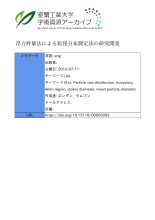Research and development of the particle size distribution analyzer by the buoyancy weighing-bar method 浮力秤量法による粒径分布測定法の研究開発
この論文にアクセスする
この論文をさがす
著者
書誌事項
- タイトル
-
Research and development of the particle size distribution analyzer by the buoyancy weighing-bar method
- タイトル別名
-
浮力秤量法による粒径分布測定法の研究開発
- 著者名
-
Tambun, Rondang
- 著者別名
-
タムブン, ロンダン
- 学位授与大学
-
室蘭工業大学
- 取得学位
-
博士 (工学)
- 学位授与番号
-
甲第326号
- 学位授与年月日
-
2012-03-23
注記・抄録
博士論文
application/pdf
The particle size distribution and mean particle size are the most important characteristics in particulate or powder technology. Various approaches have been used to measure particle size distributions. For solid-liquid systems, the particle size distributions have been measured by the Stokes diameter. The Andreasen pipette method, sedimentation balance method, centrifugal sedimentation method, etc. have been used to measure the particle size distribution in suspensions. These methods measure the migration velocities of particles in solution, and then particle size is calculated using Stokes formula. However, all these methods are time consuming and require special skills. On the other hand, a different principle can be used to analyze the particle size distribution through microscopy, laser diffraction/scattering method, and a Coulter counter method. These methods require numerous samples to accurately determine the particle size distribution. Although the laser diffraction/scattering and Coulter counter methods produce highly accurate results within a shorter time, they require extremely expensive equipment. Hence, a simple and cost effective method to determine the particle size distribution is highly demanded.The investigation of particle size distributions by the buoyancy weighing-bar method which is a novel method in particle size distribution measurement have been done for several samples particles of Japan Industrial Standard (Test Powders 1 and Test Powders 2), Sumitomo 3M (glass beads K1, K37, S60HS), polystyrene beads (spherical), nylon beads (cylindrical), etc. The influence of solid concentration, influence of shape and size of weighing bar and influence of vessel size also had been investigated in particle size distribution measurement by the buoyancy weighing-bar method. The result data obtained by the buoyancy weighing-bar method were comparable with the others particle size analyzer, such as sedimentation balance method, Andreasen pipette method, Coulter counter method, microscopy and the laser diffraction/scattering method. The buoyancy weighing-bar method is suitable for measuring the settling particle size distribution and the floating particle size distribution. The buoyancy weighing-bar method could be used to measure the particle size distribution in Stokes region and in Allen region. The particle size distribution obtained by the buoyancy weighing-bar method could be used to estimate the smaller particle size by using the Rosin-Rammler distribution. Theory was rediscussed and the new mean particle size was defined. Beside, the buoyancy weighing-bar method could be used to determine the mean particle sizes for a ternary mixture and multi-component particles in a short time. This ability is very useful in the powder industry. Similar to other methods to analyze particle size, the buoyancy weighing-bar method is accurate in an initially homogeneous suspension. Because the buoyancy weighing-bar method apparatus can be made by hand, it is also economical. Additionally, the buoyancy weighing-bar method is easier to be implemented compared to other sedimentation particle analysis methods.
